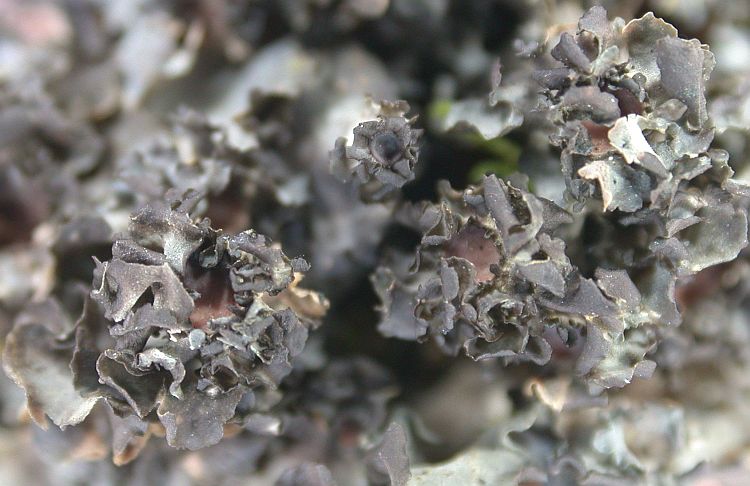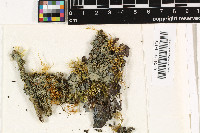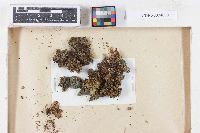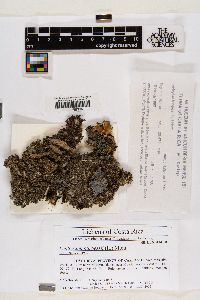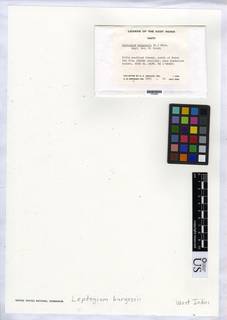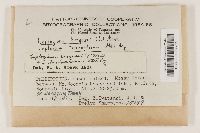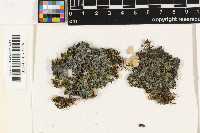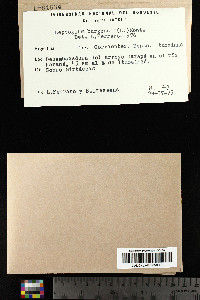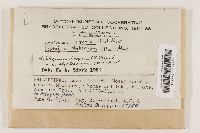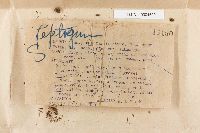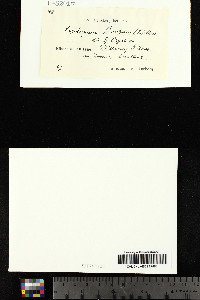
Consortium of Lichen Herbaria
- building a Global Consortium of Bryophytes and Lichens as keystones of cryptobiotic communities -
- Home
- Search
- Images
- Species Checklists
- US States: O-Z >
- US National Parks
- Central America
- South America
- US National Parks
- Southern Subpolar Region
|
|
|
|
Family: Collemataceae
[Collema burgessii (L.) Ach., moreLeptogium burgesii (L.) Mont., Lichen burgessii L., Mallotium burgessii (L.) Gray, Parmelia burgessii (L.) Ach.] |
Nash, T.H., Ryan, B.D., Gries, C., Bungartz, F., (eds.) 2004. Lichen Flora of the Greater Sonoran Desert Region. Vol 2. Thallus: foliose, 2-5(-10) cm in diam., loosely adnate, irregularly lobate lobes: very irregular, short, thin +plane, separate, (0.5-)2-5(-8) mm wide, 100-120 µm thick, only slightly swelling when wet; apices: rotund, entire to lobulate, often undulate, usually somewhat erect upper surface: brown to medium gray, usually dull, smooth or occasionally with short hairs, lacking isidia internal anatomy: with upper and lower cortices consisting of a single layer of irregularly isodiametrical cells 5-12 µm in diam., internally with loosely interwoven chains of Nostoc and hyphae lower surface: light gray or brown, smooth, with thin (c. 25 µm thick) white tomentum composed of spherical cells Apothecia: common, laminal, sessile, 1-3 mm wide disc: orange brown to red-brown to blackish brown, concave margin: thalline, concolorous with the thallus, often with microphylline appendages exciple: euparaplectenchymatous, 45-70 µm thick centrally hymenium: hyaline below and thinly yellow to brown above, 150-190 µm tall; paraphyses: unbranched, c. 1.5 µm wide, slightly inflated apically; subhymenium: pale yellow, 20-45 µm thick asci: cylindrico-clavate, 8-spored ascospores: hyaline, muriform, 5-7-septate transversely, 1-3-septate longitudinally, ovoid to ellipsoid, 25-40(-50) x 14-22 µm Pycnidia: not observed Spot tests: all negative Secondary metabolites: none detected. Substrate and ecology: on bark and among mosses on bark in montane forests World distribution: widespread in warm temperate, montane regions of Europe, Asia, Macaronesia, Africa and North and especially South America Sonoran distribution: Arizona and Chihuahua. Notes: Characteristically Leptogium burgessii has crisped lobes, that are also found on the thalline margins of the apothecia (a form without these from Mexico has been described as L. inflexum Nyl.). It has long been confused with L. digitatum, a thicker species with wrinkled thallus and different anatomy of the apothecia. The isidiate counterpart, L. laceroides, is more common in the region |
Powered by Symbiota

